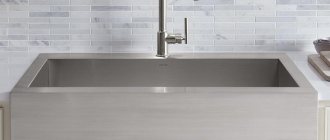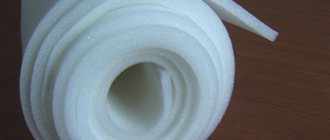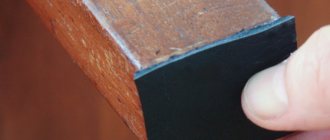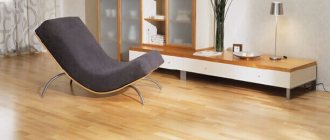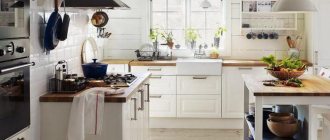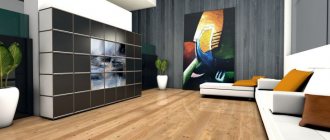Advantages and disadvantages
The popularity of linoleum as a flooring material for the kitchen is explained by a number of its advantages:
- low cost . Compared to laminate and tiles, linoleum is much cheaper (if we are talking about an artificial material), but is not inferior to them in performance properties;
- ease of laying . If the thickness of linoleum is more than 3 mm, its installation does not require prior perfect leveling of the floor. The different widths of the rolls allow you to lay the coating without seams or joints;
- softness and noiselessness . The softness and elasticity of the material makes movement on it pleasant and comfortable. It makes no noise even when walking in shoes;
- durability _ The protective layer protects the design from abrasion even under intense load. The minimum service life of linoleum is 10 years;
- moisture resistance . Linoleum is not susceptible to rotting and mold, since synthetic materials do not absorb moisture;
- low thermal conductivity . Even the material laid on a concrete base provides a warm floor; the effect can be enhanced with the help of a warm underlay;
- ease of care . For daily cleaning, it is enough to use a warm soapy solution. To clean heavy dirt and stains, special linoleum care products are available on the market.
- variety of colors and textures . Various colors, patterns and textures of the material allow you to create a unique design and any style of kitchen interior.
Before purchasing a material, you should familiarize yourself with its disadvantages:
- unstable to mechanical stress . Shoes with sharp heels, cutlery dropped on the floor, furniture lead to surface deformation;
- exposed to sunlight . If linoleum is exposed to direct sunlight for a long time, it will fade. This drawback should be taken into account by owners of kitchens located on the south side;
- has an unpleasant odor . If the kitchen is poorly ventilated, you may smell chemicals in the first months after installing artificial linoleum.
Kitchen flooring requirements
The first thing to consider is that the kitchen is the place where there is the most movement in the house. While food is being prepared and served, many feet are walked around the kitchen, and often even after dinner someone keeps coming into the kitchen to the refrigerator.
The second important detail is temperature changes, increased humidity and evaporation in the kitchen. And kitchen floors can sometimes become completely accidentally contaminated by hot grease splashing from frying pans.
Basic requirements for kitchen flooring:
- Moisture resistant and hygienic. It should be possible to regularly wet clean linoleum using detergents.
- Non-hygroscopic. Does not absorb moisture.
- Should not be slippery even when washing floors.
- Resistant to bacteria and insects.
- The surface must be resistant to abrasion.
- Durable so that a knife or fork falling on the floor will not damage it.
- Covering floor with a minimum number of joints and seams. The industry produces linoleum rolls up to 4 meters wide, so there shouldn’t be a problem with this point.
Varieties
Sometimes consumers become confused when it comes to choosing linoleum, since it differs in many ways. In fact, understanding its types is not difficult even for a person who has encountered this issue for the first time.
Natural and artificial
Natural linoleum is in no way inferior in quality and prestige to parquet or cork flooring. Its basis is non-woven materials or fiber tow. The following materials can be used to make the top layer:
- cork or wood flour;
- resin;
- linseed oil;
- lime powder;
- natural dyes.
Compared to its synthetic counterpart, natural linoleum has a higher cost, but is able to maintain its performance properties for 20-40 years. In addition to high strength and resistance to household chemicals, it is antistatic, fire resistant and environmentally friendly.
In addition to the fact that natural linoleum is safe for the inhabitants of the apartment and the environment in general, it can be recycled.
The raw material for the production of budget synthetic linoleum is polyvinyl chloride. Despite this, high-quality coating that meets the requirements of GOST is safe for human health and can be used to decorate the kitchen.
How to distinguish natural linoleum from artificial:
- by smell . Natural material has an oily smell, artificial material smells of chemicals;
- based on . On the reverse side of natural linoleum, jute fiber is clearly visible;
- by elasticity . Unlike elastic vinyl coating, natural material is much stiffer and, if desired, a piece can be broken off from it.
Homogeneous and multilayer
A homogeneous (homogeneous) coating does not have a base. Its thickness is insignificant, but the coating is elastic and durable. The service life is about 7 years, it can be increased by applying a protective layer. Due to the fact that the pattern penetrates the entire thickness of the coating, the appearance of the material does not deteriorate even with uneven wear. A distinctive feature of a homogeneous coating is a rough surface on which dirt is almost invisible.
If you buy linoleum in several pieces, make sure they are from the same batch. The shade of material from different batches may vary slightly.
Homogeneous linoleum
Multilayer (heterogeneous) coating consists of several layers:
- the basis . Felt and jute bases retain heat well, but heavy furniture and heels leave noticeable marks on it. For the kitchen, linoleum on a foam base is suitable, which is elastic and resistant to moisture and dirt;
- fiberglass . The layer is designed to enhance the heat and sound insulation of the material, as well as counteract mechanical loads. The wider it is, the more resistant the material is to deformation;
- PVC . The polyvinyl chloride layer is the basis for applying a decorative pattern;
- protective layer . Protects the material from abrasion.
The number of layers and their quality may vary among different manufacturers.
Structure of multilayer linoleum
Household and commercial
The class of linoleum is determined by the thickness and density of the protective layer, on which the service life of the material depends:
- household – up to 3 mm, class 21-23;
- semi-commercial – 4-5 mm, class 31-32;
- commercial – 6 mm and more, class from 33.
Form
Depending on the form of release, linoleum is divided into the following types:
- tiled _ Available in square, rectangular or polygonal panels. For the opportunity to create an original floor design, you will have to pay for the complexity of installation and sanitation;
- roll . The width of the rolls varies from 1.5 to 5 m, and the length can reach 45 m. This allows you to apply linoleum in one piece even in large kitchens with minimal losses during cutting;
- liquid _ A modern building material with which you can create a perfectly flat surface without seams and an unsurpassed decorative effect. Liquid linoleum, also called self-leveling flooring, is a polyurethane or epoxy resin and polymer with a hardener. The disadvantages include the difficulty of dismantling the coating.
Gallery: linoleum release forms
Liquid linoleum
Rolled linoleum
Tiled linoleum
Release forms
Not all types of linoleum are produced in the form of rolls. Some types of this flooring are available in the form of square slabs or panels resembling laminate in shape.
Material of this shape is easy to lay, and it is easy to replace damaged areas. The disadvantage of this form of release is that dirt and dust get into the seams on the floor. Over time, it leads to delamination of the material. This option is not suitable for the kitchen.
Liquid linoleum . It's not really linoleum. So, they call self-leveling polymer floors. Such floors have many advantages:
- have waterproofing properties;
- can serve as the basis for any floor covering;
- are not afraid of water;
- environmentally friendly and clean;
- can be of any color, with any pattern.
Criterias of choice
Having familiarized yourself with the varieties of linoleum, you need to take a balanced approach to its choice, analyzing each parameter.
- Material . Flaxseed oil, which is part of natural linoleum, is a powerful natural antiseptic. It will protect the floor from bacteria and harmful microorganisms throughout its entire service life. Synthetic material can also be treated with an antifungal compound, however, its properties weaken over time. Therefore, if there are small children in the house, it is better to opt for natural flooring.
- Thickness _ Since the kitchen is a room with intense traffic, it is better to use semi-commercial class linoleum with a thickness of 4-5 mm as a floor covering. It combines the ease of installation of a household coating and the high performance qualities of a commercial one.
- Coverage . The hygiene of linoleum is important for the kitchen. Therefore, if it is not possible to purchase natural material, you should choose synthetic linoleum with an antibacterial coating that prevents the growth of microbes. Unlike its artificial counterpart, natural linoleum is less moisture resistant. To eliminate the possibility of fungus formation, a special antifungal layer must be applied to the material.
- Sliding . Since the kitchen is a room with high humidity, you should take care of the safety of your household. Homogeneous natural linoleum itself has a rough surface and does not require additional coating. It is advisable to choose multi-layer synthetic material with an anti-slip coating, especially if there are children or elderly people in the house.
What to look for when purchasing
Before buying this or that material for your kitchen floor, check a few important points:
- Does the label indicate the manufacturer, production address and contact information?
- Does the seller have a certificate for goods from this batch?
- Does the selected material have a strong unpleasant odor?
- Is there a defect on the inner or outer surface?
- The drawing should be clear without blurred areas.
- The surface must be homogeneous - embossed or smooth.
- If the flooring in a room will consist of two pieces, it is important to ensure that both pieces are from the same batch, otherwise there may be a mismatch in shade or tone.
Choice of color and shade
You can choose the shade and pattern of linoleum to suit any interior style. There are floor coverings that imitate stone or ceramic tiles, marble, wood, and other materials.
For the kitchen, you should choose flooring material of variegated colors , so that small stains on it are invisible. Do not purchase plain light-colored coatings, as they are susceptible to frequent cleaning using household chemicals.
Although modern types of PVC are covered with a special protective film, household chemicals contribute to the destruction of this film. Floor coverings that imitate wood look good in any interior.
Preparing the floor for laying flooring
Before laying the flooring, make sure that the subfloor is level and rigid. The thinner the covering material you choose, the smoother and more ideal the floor on which it will be laid should be.
If you have old linoleum laid in your kitchen and there is no serious damage to it, then a new coating can be laid on top of it . Concrete floors are best leveled with pre-leveling mortars. Such solutions are poured onto the floors and leveled with special tools.
Plywood floors are prepared using wood putty. is coated with a primer before installation . This measure protects the floors from mold. Before laying the covering, the floor is thoroughly vacuumed.
Linoleum in the kitchen interior
Along with traditional PVC coverings made in beige and brown colors, linoleum with imitation of natural materials (ceramics, stone, wood), as well as expensive floor coverings (parquet, marble, mosaic) appeared on the shelves. The effect of artificial aging and the marquetry technique (mosaic of wood veneer) are very popular.
Such a variety of textures of multi-layer artificial linoleum allows you to choose a material for finishing the floor in a kitchen made in any style:
- country, Provence - a coating that imitates a solid board;
- pop art - linoleum with voluminous geometric or abstract patterns;
- modern, high-tech - plain material with a relief texture;
- classic - linoleum under ceramic tiles.
Linoleum in cool shades, with a pattern similar to small tiles, or material imitating a wooden board, laid diagonally, will help to visually increase the area of a small kitchen.
Designer recommendations for choosing linoleum:
- The color of linoleum is usually selected in accordance with the kitchen set.
- If the kitchen interior is bright enough, a harmonious balance can be created using linoleum in neutral shades. A monochromatic kitchen, on the contrary, can be “diluted” with colorful flooring.
- The large kitchen is successfully divided into functional areas (working and dining) by using linoleum of various colors or patterns.
Gallery: various linoleum designs
Linoleum in Art Nouveau style
Linoleum in the form of tiles
Linoleum for parquet boards
Varieties of linoleum that are actively used today
Linoleum in the kitchen with a tiled pattern
To choose the right material, you should know what types of linoleum there are and how they differ. Today there are the following types of linoleum:
- domestic;
- natural;
- semi-commercial;
- synthetic;
- commercial;
- PVC linoleum (or as it is commonly called “liquid floors”).
When carrying out renovations in the kitchen, it is very important to choose the right material, otherwise you can get a completely opposite effect from the renovation. When choosing it, the thickness of the linoleum, or, more precisely, the thickness of its protective coating, plays a special role. The strength of the linoleum itself directly depends on this. So, for example, in the household version its thickness ranges from 0.1 to 0.3 mm, while in the commercial version it only starts from 0.6 mm.
Despite the fact that the kitchen is located in the apartment, it cannot be considered a household space, since this is where there is an increased load. This is due to the fact that food is being prepared here, as a result of which heavy objects, knives and other things can fall onto the floor, so it is necessary to provide the floors with durable protection.
Creative linoleum in the kitchen
If you don’t know what kind of linoleum to lay in the kitchen, then in this case you should consult with a specialist in this field. It is worth noting that they all recommend laying a material with a protective layer thickness of less than 0.4 mm.
Manufacturer's choice
Today, linoleum from domestic producers is in no way inferior in quality to foreign analogues. Russian enterprises producing these products use the best foreign production technologies and high-quality materials. At the same time, the cost of imported goods is much higher due to transportation costs and the promoted brand name.
When choosing linoleum, you should pay attention to such Russian brands as Tarkett (CJSC Tarkett), Rossilin (JSC Mosstroyplastmass), Polilan (LLC Komitex Polilan). Among foreign manufacturing companies we can highlight Grabofloor (Hungary), Polyflor (Great Britain), Domofloor (Belgium), Jutekc (Slovenia).



